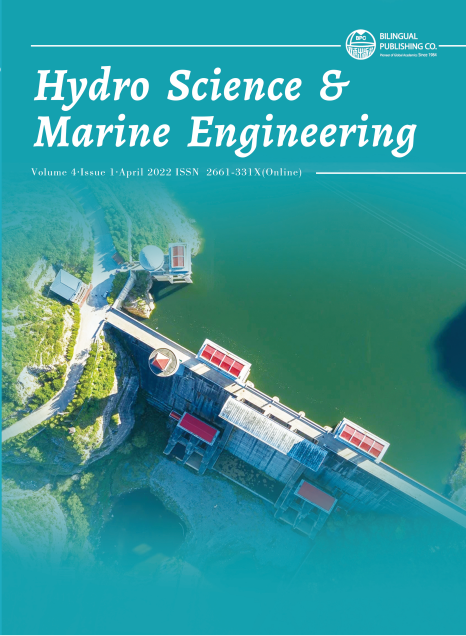Effect of Yaw Angle on Large Scale Three-blade Horizontal Axis Wind Turbines
DOI:
https://doi.org/10.30564/hsme.v4i1.4489Abstract
Offshore Horizontal Axis Wind Turbines (HAWT) are used globally as a source of clean and renewable energy. Turbine efficiency can be improved by optimizing the geometry of the turbine blades. Turbines are generally designed in a way that its orientation is adjustable to ensure the wind direction is aligned with the axis of the turbine shaft. The deflection angle from this position is defined as yaw angle of the turbine. Understanding the effects of the yaw angle on the wind turbine performance is important for the turbine safety and performance analysis. In this study, performance of a yawed HAWT is studied by computational fluid dynamics. The wind flow around the turbine is simulated by solving the Reynolds-Averaged Navier-Stokes equations using software ANSYS Fluent. The principal aim of this study is to quantify the yaw angle on the efficiency of the turbine and to check the accuracy of existing empirical formula. A three-bladed 100-m diameter prototype HAWT was analysed through comprehensive Computational Fluid Dynamics (CFD) simulations. The turbine efficiency reaches its maximum value of 33.9% at 0° yaw angle and decreases with the increase of yaw angle. It was proved that the cosine law can estimate the turbine efficiency with a yaw angle with an error less 10% when the yaw angle is between –30° and 30°. The relative error of the cosine law increase at larger yaw angles because of the power is reduced significantly.
Keywords:
Horizontal Axis Wind Turbines, Computational Fluid Dynamics, yawed angle, numerical method, aerodynamics.References
[1] Burton, T., 2011. Wind energy handbook, second edition. C (%) p15 Hydro Science & Marine Engineering | Volume 04 | Issue 01 | April 2022
[2] Hwangbo, H., Johnson, A., Ding, Y., 2017. A production economics analysis for quantifying the efficiency of wind turbines. Wind Energy (Chichester, England). 20(9), 1501-1513.
[3] Gorban, A.N., Gorlov, A.M., Silantyev, V.M., 2001. Limits of the turbine efficiency for free fluid flow. Journal of Energy Resources Technology (Transactions of the ASME). 123(4), 311-317.
[4] Jamieson, P., 2011. Innovation in wind turbine design.
[5] Dahlberg, J., Montgomerie, B., 2005. Research program of the utgrunden demonstration offshore wind farm, final report part 2, wake effects and other loads. Swedish Defense Research Agency, FOI, Kista, Sweden, Report No. FOI. pp. 02-17.
[6] Kragh, K.A., Hansen, M.H., 2015. Potential of power gain with improved yaw alignment. Wind energy (Chichester, England). 18(6), 979-989.
[7] Madsen, H.A., So̸rensen, N.N., Schreck, S., 2003. Yaw aerodynamics analyzed with three codes in
[8] comparison with experiment. Wind Energy Symposium.
[9] Schreck, S.J., Schepers, J.G., 2014. Unconventional Rotor Power Response to Yaw Error Variations. Journal of Physics: Conference Series. 555, 012001.
[10] Miao, W., Li, C., Yang, J., et al., 2016. Numerical investigation of the yawed wake and its effects on the downstream wind turbine. Journal of renewable and sustainable energy. 8(3), 33303.
[11] Noura, B., Dobrev, I., Kerfah, R., et al., 2016. Investigation of the Rotor Wake of Horizontal Axis Wind Turbine under Yawed Condition. Journal of applied fluid mechanics. 9(6), 2695-2705.
[12] Dong, X.H., Wang, H., 2021. Research on the Influence of Yaw Control on Wind Turbine Performance under Wake Effect. Advanced design and manufacturing engineering.
[13] Hau, E., Renouard, H.V., 2013. Wind Turbines: Fundamentals, Technologies, Application, Economics.
[14] Gasch, R., Twele, J., 2002. Wind Power Plants. Fundamentals, Design, Construction and Operation. Solarpraxis. Berlin, James & James Publ.
[15] Hossain, M.S., Raiyan, M.F., 2014. A comparative flow analysis of NACA 6409 and NACA 4412 aerofoil. International Journal of Research in Engineering and Technology. 3(10), 342-350.
[16] Menter, F.R., 1994. Two-equation eddy-viscosity turbulence models for engineering applications
[17] . AIAA Journal. 32(8), 1598-1605.
[18] Hattori, H., Ohiwa, N., Nagano, Y., 2005. Turbulence Model for Wall-Bounded Flow With Arbitrary Rotating Axes. Engineering Turbulence Modelling and Experiments. 6, 175-184.
[19] Bigarella, E.D.V., Azevedo, J.L.F., 2005. Numerical study of turbulent flows over launch vehicle configurations. Journal of Spacecraft and Rockets. 42(2), 266-276.
[20] Pradeep, S.P., Harikumar, A.R., 2021. The effects of winglet on hawt blade and the optimum ratio between wing and winglet dimensions. IOP conference series. Materials Science and Engineering. 1114(1).
Downloads
Issue
Article Type
License
Copyright and Licensing
The authors shall retain the copyright of their work but allow the Publisher to publish, copy, distribute, and convey the work.
Hydro Science & Marine Engineering publishes accepted manuscripts under Creative Commons Attribution-NonCommercial 4.0 International License (CC BY-NC 4.0). Authors who submit their papers for publication by Hydro Science & Marine Engineering agree to have the CC BY-NC 4.0 license applied to their work, and that anyone is allowed to reuse the article or part of it free of charge for non-commercial use. As long as you follow the license terms and original source is properly cited, anyone may copy, redistribute the material in any medium or format, remix, transform, and build upon the material.
License Policy for Reuse of Third-Party Materials
If a manuscript submitted to the journal contains the materials which are held in copyright by a third-party, authors are responsible for obtaining permissions from the copyright holder to reuse or republish any previously published figures, illustrations, charts, tables, photographs, and text excerpts, etc. When submitting a manuscript, official written proof of permission must be provided and clearly stated in the cover letter.
The editorial office of the journal has the right to reject/retract articles that reuse third-party materials without permission.
Journal Policies on Data Sharing
We encourage authors to share articles published in our journal to other data platforms, but only if it is noted that it has been published in this journal.




 Ming Zhao
Ming Zhao

